Indian Institute of Science
The Indian Institute of Science (IISc) is a public, deemed, research university for higher education and research in science, engineering, design, and management. It is located in Bangalore city, in the Indian state of Karnataka. The institute was established in 1909 with active support from Jamsetji Tata and Krishna Raja Wadiyar IV and thus is also locally known as the "Tata Institute".[4] It was granted the deemed to be university status in 1958 and the Institute of Eminence status in 2018.
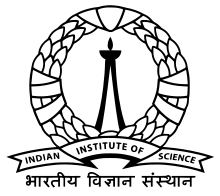 The Official Seal of IISc | |
| Type | Public research university |
|---|---|
| Established | 1909 |
| Founders | Jamsetji Tata Krishnaraja Wadiyar IV |
| Affiliation | ACU;[1] UGC; AIU, NAAC |
| Director | Anurag Kumar[2] |
Academic staff | 515[3] |
Administrative staff | 354[3] |
| Students | 3,842[3] |
| Undergraduates | 453[3] |
| Postgraduates | 947[3] |
| 2,442[3] | |
| Location | , , 560012 , |
| Campus | Urban |
| Website | www |
_Logo.svg.png) | |
The Institute places equal emphasis on student learning, with several postgraduate and PhD programmes, and a new dedicated four-year undergraduate programme, aimed at encouraging bright young students to pursue careers in the basic sciences.
In 2019, IISc launched its brand statement: "Discover and Innovate; Transform and Transcend; Serve and Lead".[5]
History
| Directors[6] |
|---|
|
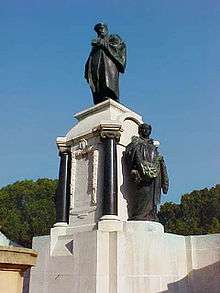
After an accidental meeting between Jamsetji Tata and Swami Vivekananda, on a ship in 1893 where they discussed Tata's plan of bringing the steel industry to India, Tata wrote to Vivekananda five years later: "I trust, you remember me as a fellow-traveller on your voyage from Japan to Chicago. I very much recall at this moment your views on the growth of the ascetic spirit in India... I recall these ideas in connection with my scheme of Research Institute of Science for India, of which you have doubtless heard or read."[10][11]
Impressed by Vivekananda's views on science and leadership abilities, Tata wanted him to guide his campaign. Vivekananda endorsed the project with enthusiasm, and Tata, with the aim of advancing the scientific capabilities of the country, constituted a Provisional Committee to prepare a plan for setting up of an Institute of research and higher education. The committee presented a draft proposal to Lord Curzon on 31 December 1898.[12] Subsequently, Sir William Ramsay, a Nobel Laureate, was called on to propose a suitable place for such an institution who suggested Bangalore as the best location.
The land and other facilities for the institution were donated on behalf of the state of Mysore by Krishna Raja Wadiyar IV, and Tata himself. The Karnataka donated about 371 acres (1.50 km2)[13] of land. (now valued about Rs 200 billion). Tata gave several buildings towards the creation of IISc. State of Karnataka also contributed Rs 500000 (now valued 12.5 million) towards capital expenditure and Rs 50000 (now valued 1.25 million) for annual expense.[14] The 7th Nizam of Hyderabad- Mir Osman Ali Khan made a big contribution in terms of money which amounted to 3 lakh Rupees over a period of 31 years.[15]
The constitution of the Institute was approved by the Viceroy, Lord Minto, and the necessary Vesting Order to enable it to function was signed on 27 May 1909.[16] Early in 1911, the Maharaja of Mysore laid the foundation stone of the Institute, and on 24 July, the first batch of students were admitted to the Departments of General and Applied Chemistry under Norman Rudolf and Electro-Technology under Alferd Hay. Within two months, the Department of Organic Chemistry was opened. In 1958 the institute was granted the deemed university status by the UGC.[17]
At the time of the inception of IISc in 1909, Morris Travers, Sir William Ramsay's co-worker in the discovery of the noble gases, became its first Director. For Travers, this was a natural continuation of his work on the Institute, since he had played a role in its founding. The first Indian Director was the Nobel Laureate Sir C.V. Raman. Raman was the Indian Science-based Nobel Laureate.[16] The current Director is Anurag Kumar.
The Institute was the first to introduce Masters programs in Engineering. It has also started integrated doctoral programs in Biological, Chemical, Physical and Mathematical Sciences for natural science graduates.[12]
In 2018, IISc was one of the first six institutes to be awarded the Institute of Eminence status.[18]
Campus
The IISc campus is located in the north of Bengaluru, about 6 kilometers from Bangalore City Railway Station and Kempegowda Bus Station, on the way to Yeshwantpur. The Institute is about 35 kilometers from Kempegowda International Airport. A number of other research institutes, Raman Research Institute, Indian Space Research Organisation (ISRO), Wood Research Institute and Central Power Research Institute (CPRI), are close to IISc. Most of these institutes are connected to IISc by a regular shuttle bus service.[19]
The campus houses more than 40 departments marked by routes such as the Gulmohar Marg, the Mahogany Marg, the Badami Marg, the Tala Marg, the Ashoka Marg, the Nilgiri Marg, the Silver Oak Marg, the Amra Marg and the Arjuna Marg. The Institute is fully residential and is spread over 400 acres of land in the heart of Bengaluru city.[20] The campus features six canteens (cafeterias), a gymkhana (gymnasium and sports complex), a football ground and a cricket ground, four dining messes (halls), one multi cuisine restaurant, nine men's and five women's hostels (dormitories), an air strip, a library, two shopping centers and residences of the faculty members and other staff, besides other amenities.
The IISc campus harbors both exotic and indigenous plant species with about 110 species of woody plants.[21] The roads on the campus are named after the dominant avenue tree species.[22]
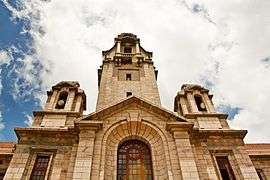 Main Building
Main Building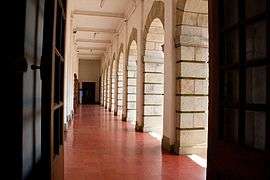 Corridors of Main Building
Corridors of Main Building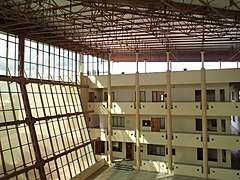 Aerospace Engineering Department (Interior)
Aerospace Engineering Department (Interior)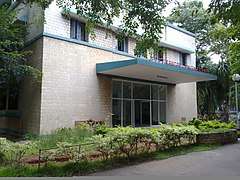 Electrical Engineering Department
Electrical Engineering Department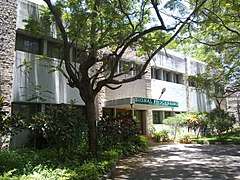 Signal Processing Building
Signal Processing Building
The architecture of the main building, which today houses the administration and the prestigious Faculty Hall, is classical in style, fronted by a grey, handsome tower. In front of it stands the work of Gilbert Bayes, a noble monument erected in the memory of J. N. Tata. At its feet is an inscription that serves to remind future generations of the generosity of Jamsetji Tata and the persistence with which he worked for the welfare of India. The building, as one of the prominent landmarks of Bengaluru, was designed by C. F. Stevens and Company of Bombay in 1912–13.[23]
The buildings for the metallurgy and aerospace departments were designed by the German architect Otto Königsberger in 1940.[24]
A second campus is in Challakere, on 1,500 acres (6.1 km2) lot of land. It currently holds the Talent Development Centre, established in 2011.[25]
Rankings
| University rankings | |
|---|---|
| Global | |
| ARWU World[26] | 401-500 (2020) |
| Leiden World[27] | 245 (2019) |
| THE World[28] | 301–350 (2020) |
| USNWR World[29] | 530 (2020) |
| QS World[30] | 184 (2020) |
| Regional | |
| Times Asia[28] | 29 (2019) |
| QS Asia[31] | 50 (2019) |
| Special | |
| THE BRICS & Emerging Economies[32] | 16 (2020) |
| QS BRICS[33] | 10 (2019) |
| QS Employability[34] | 301-500 (2020) |
QS World University rankings ranked IISc second in the world in terms of citations per faculty,[35][36] IISc was ranked 251–300 in the world by the Times Higher Education World University Rankings of 2018,[37] the top institute in India, as well as 21 in Asian the 2018 ranking[38] and 14 among BRICS & Emerging Economies University Rankings in 2017.[39] The QS World University Rankings of 2019 ranked IISc 170 in the world, as well as 51 in Asia and 10 among BRICS nations.[40] In 2019, it ranked 353rd among the universities around the world by SCImago Institutions Rankings.[41] The Academic Ranking of World Universities ranked it 301–400 in the world in 2017, the only institute in India to be ranked by this ranking.[42] It was ranked top university (1st place) in India by the National Institutional Ranking Framework university ranking for 2018[43] and 2019,[44] and overall ranking for 2018.[45]
Academic divisions, departments, and centres
For academic purposes, departments and centres in the Institute are broadly assigned to either the Science Faculty or the Engineering Faculty.[46] For administrative purposes (such as faculty recruitment, assessment and promotion), departments and centres are classified into six divisions, each headed by a Chairperson. Each department or centre is administered by a Chairperson.
| Division | Departments, Centres, and Units |
|---|---|
| Biological Sciences |
|
| Chemical Sciences |
|
| Physical and Mathematical Sciences |
|
| Electrical, Electronic, and Computer Sciences |
|
| Mechanical Sciences |
|
| Interdisciplinary Research |
|
The following centres are directly under the director (without a divisional chairman):[46]
- Archives and Publication Cell
- Centre for Continuing Education
- Center for Counseling and Support
- Centre for Scientific & Industrial Consultancy
- Centre for Sponsored Schemes and Projects
- J. R. D. Tata Memorial Library
- Office of Development and Alumni Affairs
Academic programs
Doctoral degree programs
Research students constitute more than 70% of the students on the campus. Ph.D. degrees offered in 40 different disciplines.[47] Research programs leading to doctoral degrees are the main thrust in many departments.[16] The program has a limited amount of course work, essentially to prepare the student to carry out the research, but the main emphasis is on the thesis work.[48][49][50] The annual intake of research students is approximately 250 with several candidates sponsored from educational institutions and industries.[51] The research students constitute the largest group (50%) on the campus.[51]
The Integrated Ph.D. program is designed to offer opportunities to 3-year B.Sc. graduates for pursuing advanced research in areas of biological, chemical, mathematical, and physical Sciences, leading to the Ph.D. degree.
Masters degree programs
Master's degrees offered by the institute are classified into two categories: degrees by coursework (M.Tech., M.Mgt., and M.Des.) and degrees by research [M.Tech. (research)].
The two-year M.Tech. program is available in almost all engineering departments. Due to stiff competition, one needs a high percentile in the Graduate Aptitude Test in Engineering for admission into this program. A unique feature of the programs at the institute is the credit system which allows students to tailor the courses to suit their aptitude, interest and research requirements. Most M.Tech. programs have a set of hard core courses specified as an essential requirement whereas students can take rest of the credits from many courses available in their parent or other departments and also do a dissertation work on the topic of their choice. These courses attract highly motivated accomplished students, in addition to several sponsored candidates from R&D labs/industries and also from educational institutions under the Quality Improvement Program.
The Department of Management Studies, one of the oldest management schools in the country (established in 1948), offers a Master of Management program exclusively for engineering graduates. The Center for Product Design and Manufacturing[52] offers the Master of Design (M.Des.) course. Started in 1996, the M.Des. program is a two-year, full-time postgraduate program.
Bachelors degree programs
An undergraduate programme is of age limit where for students who had completed Class XII, during the Centenary Celebrations in 2009. The first batch of students was admitted in 2011. The program offers a four-year Bachelor of Science (Research) and a five-year integrated Master of Science course in six disciplines: Biology, Chemistry, Environmental Science, Material Science, Mathematics, and Physics. The course aims at exposing the students to the inter-disciplinary nature in which scientific research is done in many upcoming fields, and comes at a time when the importance of science education at the undergraduate level is emphasised and several incentives are provided by the Government to promote the same.[53][54]
This program makes the graduates eligible to apply for post-graduate degree programs in foreign universities, many of which may require 16 years of education before entering a post-graduate degree program. In India, Bachelor of Science (Research) graduates are eligible to apply for CSIR-NET, a national level examination for securing admission into Ph.D. program into various universities including IISc.
Apart from an intensive training in sciences, courses in Engineering and Humanities are prescribed to empower the student with technical skills required for a scientist, to appreciate the social context as well as constraints of doing science.[55] The science and engineering courses are offered by the respective departments at the Institute; the humanities course is offered by the Centre for Contemporary Studies (CCS) at IISc in collaboration with the Centre for Study of Culture and Society (CSCS), Bangalore.
Students enrolled in the program take courses in Biology, Chemistry, Engineering, Humanities, Mathematics, and Physics for the first three semesters which are common and compulsory to all. In the next 4 semesters, they choose a major discipline of study and take a handful of other science courses and a stipulated number of engineering and humanities courses. The last semester is devoted to a final project. Besides, all the students, either KVPY or DST-Inspire scholars, spend a couple of months in various research institutes across the country exploring a topic or a research problem of their interest.[56][57]
Admissions process
Admission to research PhD programmes of the Institute is based on Graduate Aptitude Test in Engineering (GATE).[58] Candidates are called for interviews based on the entrance test of the Institute or GATE or National Eligibility Test. For course oriented degrees – ME and M.Tech. – the admission is through GATE conducted every year. For research-oriented degree – M.Tech.(Research)—the admission is through the GATE.[59] For Master of Management (M.Mgt), which has a ceiling strength of only 25 seats across India, the admission is through Common Admission Test. Admission to MDes is through the GATE or the Common Entrance Examination for Design. Bachelor of Science graduates can get admission to integrated PhD programs at IISc through the Joint Admission Test for M.Sc.(IIT JAM). IISc does not conduct any entrance test for providing admissions. It only organizes aptitude test & interview for PG & research courses. The institution offers UG, PG, Research & PhD courses in various fields. Admission into these courses is done through JEE Main, JEE Advanced, NEET, GATE, CEED, JAM, KVPY and other examinations.[60]
J. R. D. Tata Memorial Library
Apart from the main library, the Institute also has independent departmental libraries. The library moved into the present premises in January 1965, built out of grants provided by University Grants Commission (UGC), in commemoration of the golden jubilee celebrations of the Institute in 1959. In 1995, the library was renamed as "J. R. D. Tata Memorial Library". The National Board for Higher Mathematics (NBHM) has recognised this library as Regional Center for Mathematics for the south region and continued to award a special grant towards subscription of Journals in Mathematics.
The annual budget of the library is over Rs. 100 million[61] (almost US$2,500,000) of which subscription towards periodicals alone is about Rs. 90 million. The library currently receives over 1,734 periodical titles, of which 1381 are subscribed, while the remaining titles are received as gratis or on an exchange basis. About 600 titles are accessible through the library subscription. In addition, over 10,000 journals are accessible online, thanks to INDEST subscription. The total holdings of the library exceed 411,000 documents.
Central computing facility
The Computer Centre, established in 1970 as a central computing facility, became Supercomputer Education and Research Centre (SERC) in 1990 to provide state-of-the-art computing facility to the faculty and students of the Institute. SERC is created and fully funded by the Ministry of Human Resource Development (MHRD) to commemorate the platinum jubilee of the Institute. It houses India's first petascale supercomputer Cray XC40 and also the fastest supercomputer in India.[62][63]
Apart from functioning as a central computing facility of IISc, the SERC is engaged in education and research programs in areas relating to supercomputer development and application. The Centre is also involved in several sponsored research projects in collaboration with several high-profile government and private agencies.
Notable alumni
IISc has produced alumni who have held significant academic and industry positions around the globe:
- V. K. Aatre[64]
- Anuranjan Anand[65]
- Satya N. Atluri[66]
- Narayanaswamy Balakrishnan[67]
- Siva S. Banda[68]
- Sasanka Chandra Bhattacharyya[69]
- Tavarekere Kalliah Chandrashekar[70]
- Vadapalli Chandrasekhar[71]
- Dipankar Chatterji[72]
- Rajagopala Chidambaram[73]
- Sanjeev Das[74]
- Sanjeev Galande[75]
- S. Ganesh[76]
- Rajesh Sudhir Gokhale[77]
- Kunchithapadam Gopalan[78]
- Prashant Goswami[79]
- G. Guruswamy[80]
- Rangachar Narayana Iyengar[81]
- A. M. Jayannavar[82]
- Ritu Karidhal[83]
- P. K. Kelkar[84]
- Mohammad Islam Khan[85]
- Tapas Kumar Kundu[86]
- Pinaki Majumdar[87]
- Debasisa Mohanty[88]
- Saraju Mohanty[89]
- Jarugu Narasimha Moorthy[90]
- M. R. N. Murthy[91]
- Budaraju Srinivasa Murty[92]
- Sudha Murty[93]
- Ramakrishnan Nagaraj[94]
- Ganesh Nagaraju[95]
- Vinay K. Nandicoori[96]
- P. T. Narasimhan[97]
- Shamkant Navathe[98]
- Sethuraman Panchanathan[99]
- Swapan Kumar Pati[100]
- Aloke Paul[101]
- Beena Pillai[102]
- Thalappil Pradeep[103]
- Balaji Prakash[104]
- Ram Rajasekharan[105]
- Madan Rao[106]
- Gundabathula Venkateswara Rao[107]
- D. Srinivasa Reddy[108]
- Rajendra Prasad Roy[109]
- R. Sankararamakrishnan[110]
- V. K. Saraswat[111]
- Sagar Sengupta[112]
- Kailasavadivoo Sivan
- R. Sowdhamini[113]
- K. R. Sreenivasan[114]
- Sargur Srihari[115]
- Narayanaswamy Srinivasan[116]
- P. S. Subramanyam[117]
- Janardhana Swamy[118]
- H. V. Thulasiram[119]
- M. Vijayan[120]
- P. N. Vinayachandran[121]
- Rajindar Pal Wadhwa[122]
Notable faculty
Two former directors, C. V. Raman and C. N. R. Rao, have been awarded India's highest civilian honour Bharat Ratna.[123] Four former directors, Sir A. G. Bourne, Sir Martin O. Forster, C. V. Raman and J. C. Ghosh, have been knighted.[124][125] Among the IISc alumni, there are three Rhodes Scholars, several Fellows of the Royal Society, and thousands of members of Indian and foreign Academy of Sciences. Hundreds of IISc faculty members have also received the Shanti Swarup Bhatnagar Prize for Science and Technology awarded to Indians who have made outstanding contributions under 45 years of age. In spite of these achievements, no alumnus or serving faculty member of IISc has won either a Nobel Prize or a Fields Medal, although C. V. Raman did win a Nobel Prize before becoming the Institute's first Indian director.
- Perdur Radhakantha Adiga[126]
- Tangirala Ramasarma[127]
- P. Balaram[128]
- Dipankar Banerjee[129]
- Ganapati Shankar Bhat[130]
- Santanu Bhattacharya[131]
- Vivek Borkar[132]
- Tushar Kanti Chakraborty[133]
- Akhil Ranjan Chakravarty[134]
- Chelliah Jayabaskaran[135]
- Dipshikha Chakravortty[136]
- Nagasuma Chandra[137]
- Jayaraman Chandrasekhar[138]
- Srinivasan Chandrasekaran[139]
- Kamanio Chattopadhyay[140]
- Atul Chokshi[141]
- Saumitra Das[142]
- Devadas Devaprabhakara[143]
- Patrick D'Silva[144]
- K. R. K. Easwaran[145]
- Gilbert John Fowler[146]
- Rohini Godbole[147]
- Balasubramanian Gopal[148]
- Narayanaswamy Jayaraman[149]
- Chanda Jog[150]
- Kaushal Kishore (scientist)[151]
- H. R. Krishnamurthy[152]
- Anurag Kumar[153]
- Narendra Kumar (physicist)[154]
- Rajinder Kumar (chemical engineer)[155]
- Viswanathan Kumaran[156]
- Uday Maitra[157]
- Neelesh B. Mehta[158]
- Pramod Sadasheo Moharir[159]
- Nuggehalli Raghuveer Moudgal[160]
- Govindasamy Mugesh[161]
- Partha Sarathi Mukherjee[162]
- Manohar Lal Munjal[163]
- Kalappa Muniyappa[164]
- V. Nagaraja[165]
- Ramarathnam Narasimhan[166]
- Roddam Narasimha[167]
- Rishikesh Narayanan[168]
- Apoorva D. Patel[169]
- Patrick D'Silva[170]
- Aloke Paul[101]
- Sunil Kumar Podder[171]
- E. S. Raja Gopal[172]
- Ashok M. Raichur[173]
- Vaidyeswaran Rajaraman[174]
- G. N. Ramachandran[175]
- Subramaniam Ramakrishnan[176]
- C.V. Raman[177]
- Suryanarayanasastry Ramasesha[178]
- Sivaraj Ramaseshan[179]
- Sriram Ramaswamy[180]
- P. N. Rangarajan[181]
- Srinivasan Sampath[182]
- Kalya Jagannath Rao[183]
- C. N. R. Rao[184]
- N. Ravishankar[185]
- Dipankar Das Sarma[186]
- V. Sasisekharan[187]
- S. K. Satheesh[188]
- K. Sekar[189]
- Vijay Balakrishna Shenoy[190]
- Amit Singh[191]
- Aninda Sinha[192]
- Krityunjai Prasad Sinha[193]
- Kailasavadivoo Sivan
- Kumaravel Somasundaram[194]
- Ajay Sood[195]
- Adusumilli Srikrishna[196]
- G. S. R. Subba Rao[197]
- Utpal S. Tatu[198]
- Sundaram Thangavelu[199]
- Siva Umapathy[200]
- Giridhar Madras[201]
- Raghavan Varadarajan[202]
- Sudhir Kumar Vempati[203]
- M. Vijayan[204]
- P. N. Vinayachandran[205]
- Sandhya Srikant Visweswariah[206]
Academic and industrial collaborations
The Indian Institute of Science collaborates with various government organisations like the Indian Ordnance Factories, DRDO, the ISRO, Bharat Electronics Limited, Aeronautical Development Agency, National Aerospace Laboratories, CSIR, Department of IT (Government of India), Centre for Development of Advanced Computing, etc. IISc also works in collaboration with private industry and research labs like the Google Inc, General Motors, Microsoft Research, IBM Research, Boeing, Robert Bosch Foundation, Pratt & Whitney and more. A few organisations have been incubated by the Society for Innovation and Development (SID) on campus, including Morphing Machines and SandI, while Gamma Porite is currently under incubation. IISc actively promotes and supports ventures by the faculty, the students and alumni. Strand Life Sciences and Ittiam are some success stories of this initiative. In March 2016, a science start-up, incubated at the IISc, has built the world's first food-grade DNA/RNA stain. This might cut the time taken to diagnose conditions such as HIV to a day, from 45 days at present.[207]
Student activities
Pravega is the annual science, technology and cultural festival of Indian Institute of Science, Bangalore. Started in 2013 by the undergraduates of IISc, the fest is usually held on the third weekend of January.[208] Vijyoshi, an annual national science camp for secondary school and undergraduate students, is hosted by IISc.[209]
IISc also has active sports teams, major ones being in cricket, football, badminton and volleyball. They participate each year in the IISM (inter IISER sports meet) and a number of other tournaments and events.[210]
December 2005 terror attack
On 28 December 2005, two unknown men started firing indiscriminately inside the IISc campus. Munish Chander Puri, a professor from IIT Delhi, died in the attack. Four others were injured.[211][212]
Alumni associations
IISc has a parent alumni association (AA) in Bangalore [213] and several branches elsewhere including USA (IISCAANA).[214] Of recent parent association is involved in several disputes.[215] One of the reasons appears to be efforts by some to allow Non-IISc degree holders to become a part of the AA. Similar situation is created in IISCAANA by allowing several non-IISc members to be active in the team. IIScAANA allows those who did not complete degree to become members by adding a clause 'completed at least one semester of course work in IISc'[216] for membership eligibility.
See also
- Indian Institutes of Technology
- Tata Institute of Fundamental Research
- National Institute of Science Education and Research
- Indian Institutes of Science Education and Research
- Mobile Robotics Laboratory at IISc
- List of universities in India
- List of autonomous higher education institutes in India
- DoMS, Indian Institute of Science
- Open access in India
References
- "Association of Commonwealth Universities Membars-Asia". Retrieved 16 January 2019.
- "IISc Leadership".
- "IISc in Numbers". Indian Institute of Science. Retrieved 19 July 2016.
- "Our Heritage" (PDF). Pursuit and Promotion of Science. Indian Institute of Science. p. 18. Retrieved 19 October 2012.
- "Press Note on IISc brand Identity" (PDF).
- Revised 20 June 2015 (2008). "Indian Institute of Science Archives". Archives and Publications Cell, IISc, Bangalore. Archived from the original on 29 May 2013.
- "Indian Institute of Science: The First Hundred Years" (PDF). IISC. Retrieved 29 March 2013.
- "The Hindu: An institution builder". Hinduonnet.com. Archived from the original on 6 June 2011. Retrieved 1 September 2010.
- "Indian Academy of Sciences — Prof. S. Ramaseshan". Ias.ac.in. 10 October 1923. Retrieved 1 September 2010.
- "President's Address at the Integrity India Campaign by the CII at Coimbatore". Press Information Bureau, Government of India. 19 December 2006. Retrieved 15 June 2007.
- Gandhi, Divya (4 June 2007). "Story of IISc to be relived through an archives cell". The Hindu. Chennai, India. Retrieved 15 June 2007.
- "A Historical Perspective". Indian Institute of Science. Archived from the original on 28 May 2013. Retrieved 19 October 2012.
- Archived 30 December 2011 at the Wayback Machine
- https://www.iisc.ac.in/wp-content/uploads/2018/03/ORIGIN.pdf <\ref> "Science with a soul". Tata Group. Archived from the original on 20 February 2008. Retrieved 15 June 2007.
- "Reminiscing the seventh Nizam's enormous contribution to education". telanganatoday. 27 March 2017.
- Warrier, BS (30 January 2012). "The IISc stamp on science research". The Hindu. Chennai, India. Archived from the original on 4 February 2013. Retrieved 22 August 2015.
- "List of Institutions of higher education which have been declared as Deemed to be Universities as on 06.10.2017" (PDF). University Grants Commission. 6 October 2017. Retrieved 30 October 2017.
- "Government declares 6 educational 'Institutions of Eminence' ; 3 Institutions from Public Sector and 3 from Private Sector shortlisted". pib.gov.in (Press release). Ministry of Human Resource Development. 9 July 2018. Retrieved 15 October 2019.
- "23rd International Conference on Raman Spectroscopy". Archived from the original on 20 April 2012. Retrieved 19 October 2012.
- "In the heart of Bangalore". Retrieved 23 October 2012.
- "Flora At IISc Campus". ces.iisc.ernet.in. Retrieved 16 November 2015.
- IISc (1992) Landuse Masterplan
- "Building as landmark of Bangalore". Archived from the original on 3 April 2013. Retrieved 17 April 2013.
- Rachel Lee (2012) Constructing a Shared Vision: Otto Koenigsberger and Tata & Sons. Archived 7 January 2014 at the Wayback Machine ABE Journal 2
- "Challakere Campus". iisc.ac.in. Indian Institute of Science. Retrieved 1 September 2017.
- "Academic Ranking of World Universities - Indian Institute of Science". shanghairanking.com. Retrieved 15 February 2020.
- "CWTS Leiden Ranking 2019". Retrieved 13 October 2019.
- "THE World University Rankings - Indian Institute of Science". Times Higher Education (THE). Retrieved 15 February 2020.
- "Best Global Universities - Indian Institute of Science". U.S. News Education (USNWR). Retrieved 15 February 2020.
- "QS World University Rankings 2020". Top Universities. 13 October 2019.
- "QS Asian University Rankings 2020". Top Universities. 13 October 2019. Retrieved 13 October 2019.
- "Emerging Economies University Rankings 2020". Times Higher Education (THE). Retrieved 29 February 2020.
- QS University Rankings 2019
- https://www.topuniversities.com/university-rankings/employability-rankings/2020
- "IISc Bengaluru has world's second highest rate of citations per faculty". The Hindu. 19 June 2019. Retrieved 27 August 2019.
- Prerna Sindwani (20 June 2019). "IISc Bangalore is now the world's second best research institute". Businessinsider.in. Retrieved 27 August 2019.
- "Indian Institute of Science - QS ranking". QS World Ranking. 16 July 2015. Retrieved 10 October 2019.
- "SCImago Institutions Rankings - Higher Education - All Regions and Countries - 2019 - Overall Rank". scimagoir.com.
- "MHRD, National Institute Ranking Framework (NIRF)". nirfindia.org. Retrieved 15 November 2019.
- "MHRD, National Institute Ranking Framework (NIRF)". nirfindia.org. Retrieved 15 November 2019.
- "MHRD, National Institute Ranking Framework (NIRF)". nirfindia.org. Retrieved 15 November 2019.
- "Indian Institute of Science, Bangalore". www.iisc.ernet.in. Retrieved 16 November 2015.
- Research Programmes, http://www.iisc.ac.in/admissions/research-programmes/
- "Welcome to Department of Mechanical Engineering, IISc". Mecheng.iisc.ernet.in:8080. Archived from the original on 3 March 2012. Retrieved 26 October 2012.
- "Electrical Communication Engineering, IISc". Ece.iisc.ernet.in. Archived from the original on 11 November 2012. Retrieved 26 October 2012.
- "Supercomputer Education and Research Centre(Academics)". Serc.iisc.ernet.in. Archived from the original on 31 August 2012. Retrieved 26 October 2012.
- Archived 30 December 2011 at the Wayback Machine
- "CPDM, Indian Institute of Science". Cpdm.iisc.ernet.in. Retrieved 26 October 2012.
- "IISc UG Website". IISc. Retrieved 3 July 2013.
- "Times of India". Times of India. 13 June 2011. Retrieved 3 July 2013.
- "IISc UG Website". IISc. Retrieved 3 July 2013.
- "KVPY". KVPY, DST, Government of India. Retrieved 3 July 2013. External link in
|publisher=(help) - "Innovation in Science Pursuit for Inspired Research (INSPIRE)-FAQ.pdf" (PDF). Retrieved 22 August 2015.
- Entry Modes into IISc, http://www.iisc.ac.in/wp-content/uploads/2017/04/admission-Flow-Chart.pdf
- "Indian Institute of Science". Admissions.iisc.ernet.in. Retrieved 26 October 2012.
- "IISc Bangalore Online admission website". IISc. Retrieved 28 June 2018.
- "About J R D Tata Memorial Library". Archived from the original on 19 February 2012. Retrieved 17 February 2012.
- "SERC — India". Archived from the original on 29 November 2018. Retrieved 29 July 2016.
- "ET — India".
- Dr. VK Aatre Appointed New SA To RM, https://drdo.gov.in/drdo/pub/nl/Feb2000/appointednlfeb.htm
- Indian Academy of Sciences Fellow profile, http://www.ias.ac.in/describe/fellow/Anand,_Prof._Anuranjan
- Prof. S. N. Atluri, https://www.depts.ttu.edu/coe/CARES/atluri.php
- "INSA-Narayanaswamy Balakrishnan". INSA. 2015. Retrieved 22 October 2017.
- Dr. Siva S. Banda, https://archive.today/20121212203234/http://www.af.mil/information/bios/bio.asp?bioID=4596
- "Deceased fellow-Sasanka Chandra Bhattacharyya". Indian National Science Academy. 2016. Retrieved 22 October 2017.
- "T. K. Chandrashekar on NISER". National Institute of Science Education and Research. 2016. Retrieved 22 October 2017.
- "Vadapalli Chandrasekhar-Biography" (PDF). The World Academy of Sciences. 2016. Retrieved 22 October 2017.
- "INSA :: Indian Fellow Detail". Insaindia.res.in. Retrieved 27 August 2019.
- Rajagopala Chidambaram, http://www.barc.gov.in/leaders/rc.html
- "Biographical Information – Sanjeev Das". Regional Centre for Biotechnology. 9 November 2017. Archived from the original on 5 November 2017. Retrieved 9 November 2017.
- "Scientist Sanjeev Galande selected for GD Birla Award". The Hindu. 15 July 2015. Retrieved 31 October 2016.
- "About the PI". home.iitk.ac.in. 16 January 2018. Retrieved 16 January 2018.
- "Fellow profile – RS Gokhale". Indian Academy of Sciences. 2016. Retrieved 22 October 2017.
- "Kunchithapadam Gopalan-Indian fellow". Indian National Science Academy. 2016. Retrieved 22 October 2017.
- "Dr. Prashant Goswami, Director". National Institute of Science, Technology and Development Studies. 2016. Archived from the original on 22 October 2017. Retrieved 22 October 2017.
- "NAS Staff Page: Guru Guruswamy, Ph.D". Nas.nasa.gov. Retrieved 27 August 2019.
- Raja Ramanna Fellow at IISc, Bangalore, http://civil.iisc.ernet.in/~rni/
- "INSA :: Indian Fellow Detail – Professor AM Jayannavar". insaindia.res.in. Retrieved 21 October 2017.
- https://www.outlookindia.com/website/story/india-news-she-was-curious-to-know-what-lay-beyond-the-sky-meet-chandrayaan-2-mission-director-ritu-srivastava/334684
- Dr. P.K. Kelkar, 1909-1990 By Ms. Madhura Gopinath, http://pkkelkar.info/index.html Archived 18 March 2018 at the Wayback Machine
- "National Biosciences Award to Dr M. I. Khan". Council of Scientific and Industrial Research. 15 June 2003. Retrieved 5 December 2017.
- "Indian fellow – T K Kundu". Indian National Science Academy. 2016. Retrieved 22 October 2017.
- "Biographical Information-Pinaki Majumdar". Harish-Chandra Research Institute. 31 October 2017. Retrieved 31 October 2017.
- "Debasisa Mohanty on NII". nii.res.in. 21 January 2018. Retrieved 21 January 2018.
- University of North Texas Faculty Information System, http://facultyinfo.unt.edu/faculty-profile?profile=sm0285
- "Jarugu Narasimha Moorthy-Biodata on IITK" (PDF). IIT Kanpur. 2016. Retrieved 22 October 2017.
- Prof. M.R.N. Murthy Laboratory, http://mbu.iisc.ernet.in/~mrnlab/
- "B. S. Murty-Faculty profile". IIT Madras. 2017. Retrieved 22 October 2017.
- Sudha Murthy, https://www.infosys.com/infosys-foundation/about/trustees/
- "Indian fellow – Nagaraj". Indian National Science Academy. 2016. Retrieved 22 October 2017.
- "DNA Repair and Disease Laboratory - Indian Institute of Science". biochem.iisc.ernet.in. 14 May 2018. Retrieved 14 May 2018.
- "Profile on CSIR" (PDF). Council of Scientific and Industrial Research. 23 January 2018. Retrieved 23 January 2018.
- "Indian fellow-P. T. Narasimhan". Indian National Science Academy. 2016. Retrieved 22 October 2017.
- Shamkant B. Navathe, https://www.cc.gatech.edu/~sham/
- Sethuraman "Panch" Panchanathan, Executive Vice President, ASU Knowledge Enterprise, Chief Research and Innovation Officer, https://research.asu.edu/about-us/knowledge-enterprise-leadership
- "Faculty profile-Swapan Kumar Pati". Jawaharlal Nehru Centre for Advanced Scientific Research. 2016. Retrieved 22 October 2017.
- "Biographical Information – Aloke Paul". Indian Institute of Science. 3 November 2017. Retrieved 3 November 2017.
- "Beena Pillai CV Jun 2015_Medium.pdf". Google Docs. 14 January 2019. Retrieved 14 January 2019.
- "Profile of Professor T. Pradeep". Dstuns.iitm.ac.in. Retrieved 18 October 2013.
- Ailza (21 January 2018). "BSBE Faculty". iitk.ac.in. Retrieved 21 January 2018.
- Prof. (Dr.) P.B. Sharma; Prof. (Dr.) Padmakali Banerjee; Prof. (Dr.) Jai Paul Dudeja, Prof. (Dr.) Priti Singh, Dr. Ranjeet K. Brajpuriya (1 October 2015). Making Innovations Happen. Allied Publishers. pp. 8–. ISBN 978-81-8424-999-6.CS1 maint: multiple names: authors list (link)
- "Madan Rao - Distinguished Alumnus 2016". Indian Institute of Technology, Bombay. 22 October 2017. Retrieved 22 October 2017.
- "Gundabathula Venkateswara Rao-Fellow profile". Indian Academy of Sciences. 2016. Retrieved 22 October 2017.
- "D. Srinivasa Reddy-Biography" (PDF). National Chemical Laboratory. 2016. Retrieved 22 October 2017.
- "Fellow profile – RP Roy". Indian Academy of Sciences. 17 December 2017. Retrieved 17 December 2017.
- "BSBE Faculty – R.Sankararamakrishnan". IIT Kanpur. 11 January 2018. Retrieved 11 January 2018.
- Shri V K Saraswat, Former Secretary Defence R&D Member, NITI Aayog, http://niti.gov.in/writereaddata/files/member_profile/vk_saraswat-profile.pdf
- "Sagar Sengupta on NII". nii.res.in. 27 January 2018. Retrieved 27 January 2018.
- "Fellow profile". Indian Academy of Sciences. 26 December 2017. Retrieved 26 December 2017.
- Katepalli R. Sreenivasan, President and Dean of Engineering at NYU, http://engineering.nyu.edu/about/leadership
- Sargur N. Srihari (Hari), http://www.cedar.buffalo.edu/~srihari/
- "Fellow profile – N. Srinivasan". Indian Academy of Sciences. 2016. Retrieved 22 October 2017.
- P. S. Subramanyam, Director, Aeronautical Development Agency, https://www.ada.gov.in/
- Janardhana Swamy, Member of the Indian Parliament for Chitradurga, http://www.jswamy.com/
- "Education and Experience". ncl-india.org. 15 May 2018. Retrieved 15 May 2018.
- Prof. M. Vijayan, http://mbu.iisc.ernet.in/~mvlab/
- Dr. P. N. Vinayachandran, https://web.archive.org/web/20080520102826/http://caos.iisc.ernet.in/faculty/vinay.html
- List of Recipients of Bharat Ratna, http://mha.nic.in/sites/upload_files/mha/files/RecipientsBR_140515.pdf Archived 10 June 2017 at the Wayback Machine
- C. V. Raman, https://www.famousscientists.org/c-v-raman/
- An institution builder, http://www.thehindu.com/seta/2002/12/12/stories/2002121200120300.htm
- "Deceased fellow-Adiga". Indian National Science Academy. 8 November 2017. Retrieved 8 November 2017.
- "Indian Fellow-T. Tamasarma". INSA. 28 December 2018. Retrieved 28 December 2018.
- "Indian Fellow-P. Balaram". INSA. 30 October 2017. Retrieved 30 October 2017.
- "Faculty profile – Dipankar Banerjee". Indian Academy of Sciences. 18 December 2017. Retrieved 18 December 2017.
- "G. S. Bhat on CAOS". CAOS, Indian Institute of Science. 8 November 2017. Archived from the original on 10 November 2017. Retrieved 8 November 2017.
- "Santanu Bhattacharya". Indian Institute of Science. 8 November 2017. Retrieved 8 November 2017.
- "Indian fellow-Vivek Borkar". Indian National Science Academy. 8 November 2017. Retrieved 8 November 2017.
- "Faculty profile-Tushar Kanti Chakraborty". Indian Institute of Science. 8 November 2017. Retrieved 8 November 2017.
- "Indian fellow". Indian National Science Academy. 8 November 2017. Retrieved 8 November 2017.
- "Faculty profile". Indian Institute of Science. 28 December 2018. Archived from the original on 26 June 2018. Retrieved 28 December 2018.
- "Faculty profile". Indian Institute of Science. 25 January 2018. Archived from the original on 17 November 2018. Retrieved 25 January 2018.
- "Faculty profile". biochem.iisc.ernet.in. Retrieved 17 January 2018.
- "Jayaraman Chandrasekhar – Faculty profile". Indian Institute of Science. 2016.
- "Indian fellow-Srinivasan Chandrasekaran". Indian National Science Academy. 2016.
- "Indian fellow-Kamanio Chattopadhyay". Indian National Science Academy. 2016.
- "Indian fellow-Atul Chokshi". Indian National Science Academy. 8 November 2017. Retrieved 8 November 2017.
- "Laboratory of Dr. Saumitra Das". mcbl.iisc.ac.in. 19 December 2017. Retrieved 19 December 2017.
- "Brief Profile of the Awardee-Devadas Devaprabhakara". Shanti Swarup Bhatnagar Prize. 8 November 2017. Retrieved 8 November 2017.
- "Patrick D' Silva - Division of Biological Sciences, Indian Institute of Science". bio.iisc.ac.in. 14 May 2018. Retrieved 14 May 2018.
- "Indian Fellow – Easwaran". Indian National Science Academy. 8 November 2017. Retrieved 8 November 2017.
- Giri, K.V.; Rajagopalan R.; Pillai, S.C. (8 November 2017). "Gilbert J. Fowler-Obituary" (PDF). Current Science. 22 (4): 108.
- "Indian Fellow-R. Godbole". Archived from the original on 29 March 2014. Retrieved 29 March 2014.
- "Indian fellow-Balasubramanian Gopal". Indian National Science Academy. 2016. Retrieved 2 November 2016.
- "Faculty profile-Narayanaswamy Jayaraman". Indian Institute of Science. 2016. Archived from the original on 20 December 2016. Retrieved 8 November 2017.
- "Indian Fellow: Chanda Jog". Indian National Science Academy. Archived from the original on 9 March 2015. Retrieved 7 March 2015.
- "Deceased fellow-Kaushal Kishore". Indian National Science Academy. 2016.
- "Prof. H. R. Krishnamurthy". IISc Physics Department. 1 October 2018. Retrieved 1 October 2018.
- "Indian Fellow-Anurag Kumar". Indian National Science Academy. 8 November 2017. Retrieved 8 November 2017.
- "Curriculum Vitae on RRI-Narendra Kumar". Raman Research Institute. 2017. Archived from the original on 9 February 2004. Retrieved 22 October 2017.
- "Indian fellow-Rajinder Kumar". Indian National Science Academy. 2016.
- "Indian fellow-Viswanathan Kumaran". Indian National Science Academy. 2016. Archived from the original on 22 August 2019.
- "Faculty profile-Uday Maitra". Indian Institute of Science. 2016. Archived from the original on 15 March 2018. Retrieved 8 November 2017.
- "Brief Profile of the Awardee-Neelesh B. Mehta". Shanti Swarup Bhatnagar Prize. 21 October 2017. Retrieved 21 October 2017.
- V. P. Dimri (April 2003). "Pramod Sadasheo Moharir (1943–2003)" (PDF). Current Science. 84 (7).
- "Deceased fellow-Moudgal". Indian National Science Academy. 2016. Retrieved 22 October 2017.
- "Brief Profile of the Awardee-Govindasamy Mugesh". Shanti Swarup Bhatnagar Prize. 2016. Retrieved 12 November 2016.
- "Biography-Partha Sarathi Mukherjee" (PDF). Indian Institute of Science. 2016. Archived from the original (PDF) on 25 October 2017. Retrieved 8 November 2017.
- "Indian fellow-Manohar Lal Munjal". Indian National Science Academy. 2016.
- "Brief Profile of the Awardee-Kalappa Muniyappa". Shanti Swarup Bhatnagar Prize. 2016. Retrieved 5 October 2016.
- "Brief Profile of the Awardee – Valakunja Nagaraja". SSB Prize. 8 November 2017. Retrieved 8 November 2017.
- "Indian fellow-Ramarathnam Narasimhan". Indian National Science Academy. 2016.
- "Honour for scientist Roddam Narasimha". The Hindu.com. Associated Press. 22 September 2009. Retrieved 30 May 2012.
- "Brief Profile of the Awardee-Rishikesh Narayanan". Shanti Swarup Bhatnagar Prize. 2016. Retrieved 5 October 2016.
- "Life force". New Scientist. 2016. Retrieved 5 October 2016.
- Renganathan, Vigneshwaran (14 May 2018). "People - Molecular Chaperone Lab". pdslab.biochem.iisc.ernet.in. Retrieved 14 May 2018.
- "Former Faculty-Sunil Kumar Podder". Indian Institute of Science. Retrieved 30 September 2016.
- "About the Speaker-E. S. Raja Gopal". IISER, Thiruvananthapuram. 2017.
- "Faculty profile". materials.iisc.ernet.in. 20 January 2018. Retrieved 20 January 2018.
- "Indian Fellow-Vaidyeswaran Rajaraman". Indian National Science Academy. 2016. Retrieved 24 May 2016.
- Vijayan, M.; Johnson, L. N. (2005). "Gopalasamudram Narayana Ramachandran. 8 October 1922 – 7 April 2001: Elected FRS 1977". Biographical Memoirs of Fellows of the Royal Society. 51: 367–377. doi:10.1098/rsbm.2005.0024.
- "Brief Profile of the Awardee-Subramaniam Ramakrishnan". Shanti Swarup Bhatnagar Prize. 2016. Retrieved 12 November 2016.
- "Raman, Sir Chandrasekhara Venkata". Encyclopædia Britannica, Inc. 2007. Retrieved 11 September 2007.
- "Brief Profile of the Awardee-Suryanarayanasastry Ramasesha". Shanti Swarup Bhatnagar Prize. 2016. Retrieved 12 November 2016.
- "Prof. Ramaseshan passes away". The Hindu. 30 December 2003.
- "Sriram Ramaswamy-Biography". Royal Society. 8 November 2017. Archived from the original on 29 April 2016. Retrieved 8 November 2017.CS1 maint: BOT: original-url status unknown (link)
- "Faculty Profile-P. N. Rangarajan". Indian Institute of Science. 2017.
- "Brief Profile of the Awardee-Srinivasan Sampath". Shanti Swarup Bhatnagar Prize. 2016. Retrieved 12 November 2016.
- "Brief Profile of the Awardee-KJ Rao". Shanti Swarup Bhatnagar Prize. 2016. Retrieved 12 November 2016.
- "Professor CNR Rao profile". Jawaharlal Nehru Centre for Advanced Scientific Research. 2011. Retrieved 16 November 2013.
- "Brief Profile of the Awardee-N. Ravishankar". Shanti Swarup Bhatnagar Prize. 2017.
- "INSA". INSA-Dipankar Das Sarma. 8 November 2017. Archived from the original on 13 August 2016. Retrieved 8 November 2017.
- "Indian Fellow – Sasisekharan". Indian National Science Academy. 2016. Retrieved 23 September 2016.
- "Brief Profile of the Awardee-S. K. Satheesh". Shanti Swarup Bhatnagar Prize. 2016. Retrieved 12 November 2016.
- "Faculty profile". physics.iisc.ernet.in. 14 December 2017. Retrieved 14 December 2017.
- "Prof. Vijay B. Shenoy". IISc Physics Department. 1 October 2018. Retrieved 1 October 2018.
- "Centre for Infectious Disease Research (CIDR) Group Leader". cidr.iisc.ernet.in. 11 January 2019. Archived from the original on 12 January 2019. Retrieved 11 January 2019.
- "Aninda Sinha". Perimeter Institute for Theoretical Physics. Retrieved 15 August 2016.
- "Indian fellow-K.P. Sinha". Indian National Science Academy. 3 November 2017. Archived from the original on 27 April 2017. Retrieved 3 November 2017.
- "K. Somasundaram – Division of Biological Sciences, Indian Institute of Science". bio.iisc.ac.in. 23 December 2017. Retrieved 23 December 2017.
- "IISC Profile-Ajay Sood" (PDF). IISC. 2014. Retrieved 18 October 2014.
- "Deceased fellow-Adusumilli Srikrishna". Indian National Science Academy. 2016.
- "Indian fellow-G. S. R. Subba Rao". Indian National Science Academy. 2016.
- "Utpal S. Tatu – Division of Biological Sciences, Indian Institute of Science". bio.iisc.ac.in. 6 January 2018. Retrieved 6 January 2018.
- "Professor S Thangavelu". Indian Institute of Science. Retrieved 29 June 2013.
- "Brief Profile of the Awardee-Siva Umapathy". Shanti Swarup Bhatnagar Prize. 2016. Retrieved 12 November 2016.
- "IISc Honours 8 Faculty Members". The Indian Express. 10 May 2015. Retrieved 21 August 2016.
- "Indian fellow – Varadarajan". Indian National Science Academy. 2016. Retrieved 11 October 2016.
- "SERB profile" (PDF). Science and Engineering Research Board. 25 December 2018. Retrieved 25 December 2018.
- "M. Vijayan on IISc". IISc. 8 November 2017. Retrieved 8 November 2017.
- "Brief Profile of the Awardee-PN Vinayachandran". SSB Prize. 8 November 2017. Retrieved 8 November 2017.
- "Prof. Sandhya S. Visweswariah". IISc. 8 November 2017. Archived from the original on 26 October 2017. Retrieved 8 November 2017.
- Reporter, B. S. "IISc start-up builds world's first food grade DNA/RNA stain". Retrieved 13 June 2016.
- "Get ready for Pravega", The Hindu
- "National Science (VIJYOSHI) Camp 2014". 19 February 2015. Archived from the original on 19 February 2015. Retrieved 16 December 2015.
- "IISM 2016", IISER Kolkata
- Reporter, Staff (27 December 2015). "Ten years on, IISc. attack mastermind at large" – via www.thehindu.com.
- "IISC's Security Was Beefed Up After the Attack 10 Years Ago".
- "IISc Alumni Association | IISc alumni association website". Iiscalumni.com. Retrieved 27 August 2019.
- "About Us". Iiscaana.org. Retrieved 27 August 2019.
- "Archived copy". Archived from the original on 15 February 2019. Retrieved 15 February 2019.CS1 maint: archived copy as title (link)
- "Membership Fee & How to become a Member ?". Iiscaana.org. Retrieved 27 August 2019.